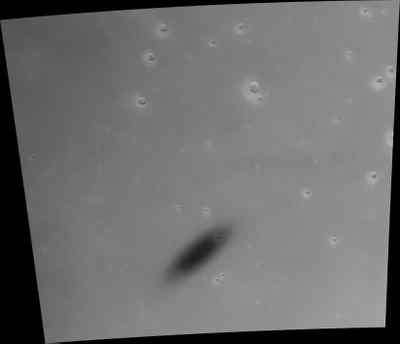Avi Blizovsky

This image, taken by the XNUMXD High Resolution Camera (HRSC) aboard the Mars Express spacecraft, showed the fast shadow of the moon Phobos as it crosses the surface of Mars.
The spacecraft captured the unique image during orbit 2345 in November 2005. These observations would not have been possible without the collaboration between the camera team at the Institute for Planetary Research at DLR (Germany) and the European Space Agency teams, especially the mission engineers at the European Space Agency Operations Center in Darmstadt, Germany.
They confirmed the model of Phobos' orbit as determined in 2004, also based on HRSC images. They also showed that thanks to precise planning, even a moving object can be captured by the cameras in exactly the predicted position. The basis for these observations is the precise knowledge of the position of the spacecraft in orbit as well as of the target site on Mars within a few hundred meters.
Phobos is the largest of the moons of Mars, its size is 27 by 22 kilometers and it moves around Mars in an almost circular orbit at an altitude of about 6,000 kilometers. Phobos takes a little over 7.5 hours to complete one orbit around the planet.
When it is between Mars and the sun, Phobos creates a small, diffuse shadow on the surface of Mars. To an observer on Mars this will look like a fast eclipse, similar to eclipses on Earth when the Moon covers the Sun's disk but it does so much more slowly.
The shadow of Phobos on the ground of Mars is elliptical in shape, because the cone of the shadow reaches Mars at an oblique angle. The shadow looks even more distorted due to the HRSC photography technique. The shadow crosses the surface at a speed of about 7,200 km/h from west to east. The spacecraft moves faster at about 12 km/h in an almost polar orbit from south to north.
Because HRSC's scanners scan the surface synchronously with the speed of the spacecraft that houses the camera, Mars Express, it takes time to cover the full size of the shadow. However, in a short time the moon moves on and therefore the shape of the shadow is smeared in the HRSC photograph. A striking phenomenon, according to which the shadow is darker in the center than at the edges, is explained again using an imaginary observer on Mars. Due to its small size, Phobos covers only about 20% of the Sun's disk.
Even if the observer stands in the center of the shadow, he will still be illuminated by the uncovered part of the sun's disc, and will see a sort of partial eclipse instead of a total eclipse.
Members of the instrument's scientific team recalculated Phobos' orbit based on photographs taken by the camera in 2004. The improved determination of the orbit revealed that the moon had advanced about 12 kilometers relative to the previous forecast. Now it was possible to calculate the exact times when the shadow would be observed. In the end it was possible to identify the accuracy of the improved trajectory determination thanks to the exact position of the shadow in the new image.
For the news in Universe Today
Yedan Mars Express
https://www.hayadan.org.il/BuildaGate4/general2/data_card.php?Cat=~~~408803442~~~256&SiteName=hayadan
